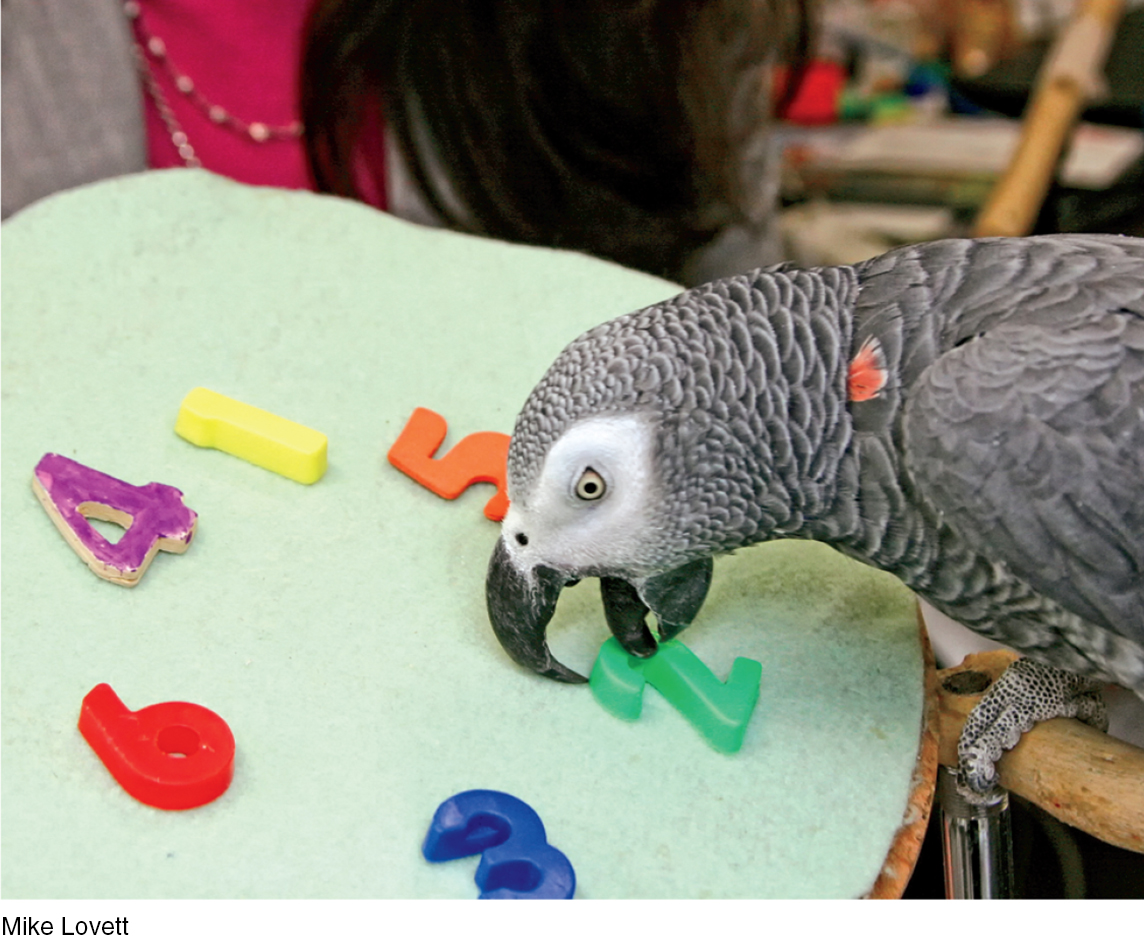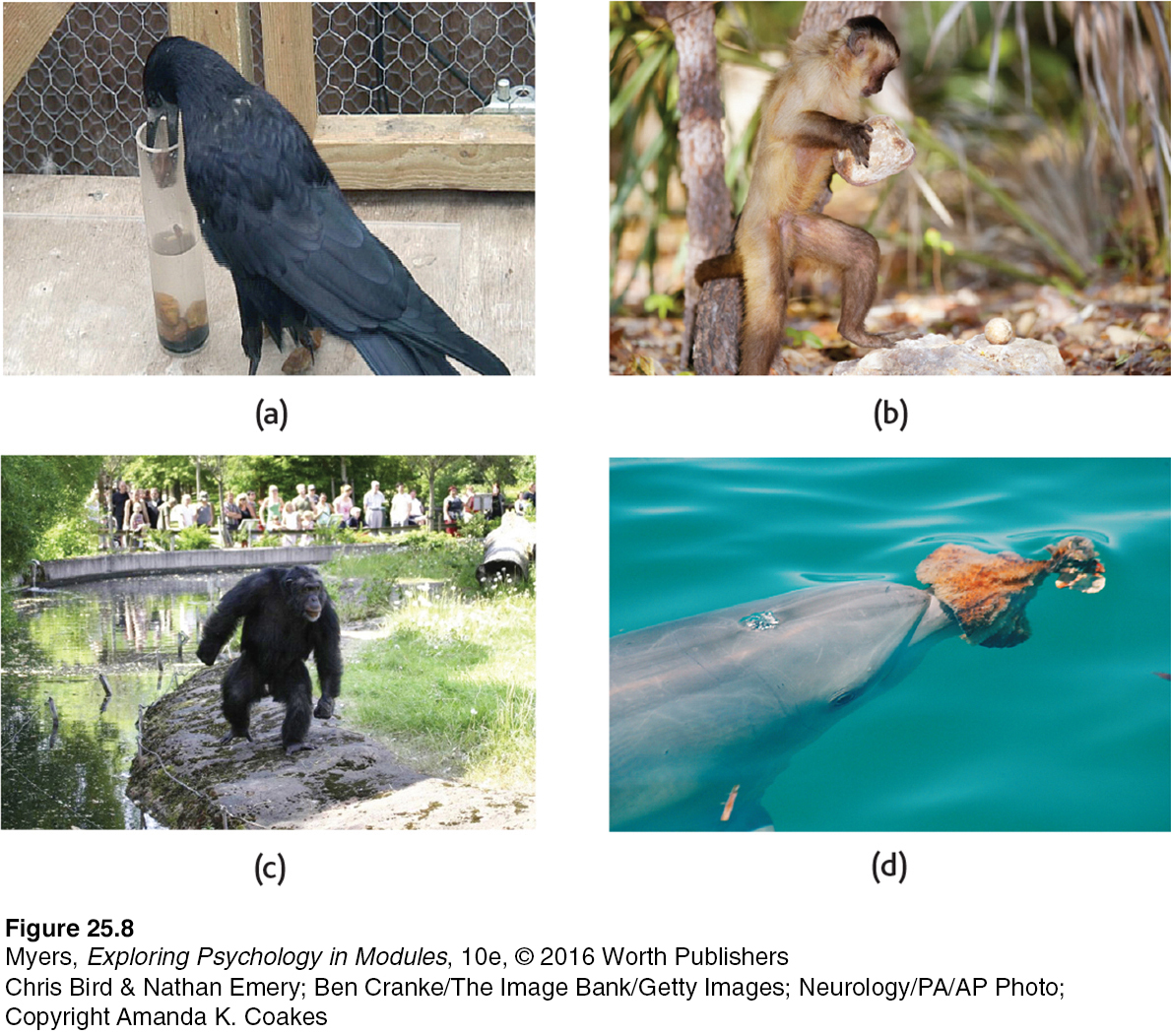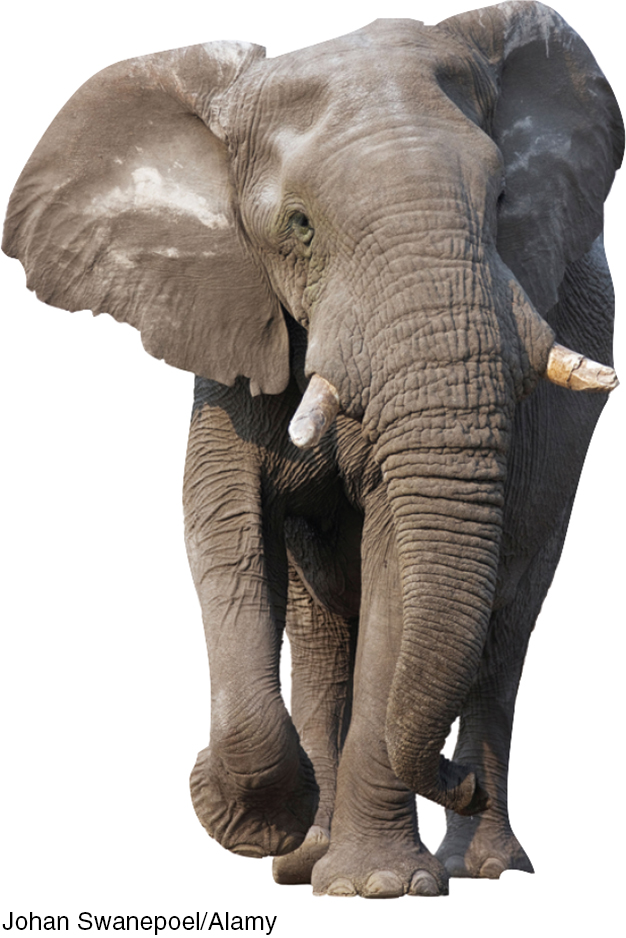25.5 Do Other Species Share Our Cognitive Skills?
25-7 What do we know about thinking in other animals?
Other animals are smarter than we often realize. In her 1908 book, The Animal Mind, pioneering psychologist Margaret Floy Washburn explained that animals’ consciousness and intelligence can be inferred from their behavior. In 2012, neuroscientists convening at the University of Cambridge added that animal consciousness can also be inferred from animals’ brains: “Nonhuman animals, including all mammals and birds,” possess the neural networks “that generate consciousness” (Low et al., 2012). Consider, then, what animal brains can do.
Using Concepts and Numbers
Even pigeons—mere birdbrains—can sort objects (pictures of cars, cats, chairs, flowers) into categories, or concepts. Shown a picture of a never-before-seen chair, pigeons have reliably pecked a key that represents chairs (Wasserman, 1995). By touching screens in quest of a food reward, black bears have learned to sort pictures into animal and nonanimal categories (Vonk et al., 2012). The great apes also form concepts, such as cat and dog. After monkeys learned these concepts, certain frontal lobe neurons in their brain fired in response to new “catlike” images, others to new “doglike” images (Freedman et al., 2001).

Animal cognition in action Until his death in 2007, Alex, an African Grey parrot, categorized and named objects (Pepperberg, 2009, 2012, 2013). Among his jaw-dropping numerical skills was the ability to comprehend numbers up to 8. He could speak the number of objects. He could add two small clusters of objects and announce the sum. He could indicate which of two numbers was greater. And he gave correct answers when shown various groups of objects. Asked, for example, “What color four?” (meaning “What’s the color of the objects of which there are four?”), he could speak the answer.
Mike Lovett
Displaying Insight
Page 327
Psychologist Wolfgang Köhler (1925/1957) showed that we are not the only creatures to display insight. He placed a piece of fruit and a long stick outside the cage of a chimpanzee named Sultan, beyond his reach. Inside the cage, he placed a short stick, which Sultan grabbed, using it to try to reach the fruit. After several failed attempts, he dropped the stick and seemed to survey the situation. Then suddenly (as if thinking “Aha!”), Sultan jumped up and seized the short stick again. This time, he used it to pull in the longer stick—which he then used to reach the fruit. Apes have even exhibited foresight by storing a tool they could use to retrieve food the next day (Mulcahy & Call, 2006). Birds, too, have displayed insight. One experiment, by (yes) Christopher Bird and Nathan Emery (2009), has brought to life an Aesop fable in which a thirsty crow was unable to reach the water in a partly filled pitcher. See its solution in FIGURE 25.8a.

Figure 9.8: FIGURE 25.8 Animal talents (a) Crows studied by Christopher Bird and Nathan Emery (2009) quickly learned to raise the water level in a tube and nab a floating worm by dropping in stones. Other crows have used twigs to probe for insects, and bent strips of metal to reach food. (b) Capuchin monkeys have learned not only to use heavy rocks to crack open palm nuts, but also to test stone hammers and select a sturdier, less crumbly one (Visalberghi et al., 2009). (c) One male chimpanzee in Sweden’s Furuvik Zoo was observed every morning collecting stones into a neat little pile, which later in the day he used as ammunition to pelt visitors (Osvath & Karvonen, 2012). (d) Dolphins form coalitions, cooperatively hunt, and learn tool use from one another (Bearzi & Stanford, 2010). This bottlenose dolphin in Shark Bay, Western Australia, belongs to a small group that uses marine sponges as protective nose guards when probing the sea floor for fish (Krützen et al., 2005).
Chris Bird & Nathan Emery
Ben Cranke/The Image Bank/Getty Images
Neurology/PA/AP Photo
Copyright Amanda K. Coakes
Using Tools and Transmitting Culture
Like humans, many other species invent behaviors and transmit cultural patterns to their observing peers and offspring (Boesch-Achermann & Boesch, 1993). Forest-dwelling chimpanzees select different tools for different purposes—a heavy stick for making holes, or a light, flexible stick for fishing for termites (Sanz et al., 2004). Researchers have found at least 39 local customs related to chimpanzee tool use, grooming, and courtship (Claidière & Whiten, 2012; Whiten & Boesch, 2001). One group may slurp termites directly from a stick, another group may pluck them off individually. One group may break nuts with a stone hammer, their neighbors with a wooden hammer. These group differences, along with differing communication and hunting styles, are the chimpanzee version of cultural diversity.

Johan Swanepoel/Alamy
Page 328
Other animals have also shown surprising cognitive talents. In tests, elephants have demonstrated self-awareness and displayed their abilities to learn, remember, discriminate smells, empathize, cooperate, teach, and spontaneously use tools (Byrne et al., 2009). As social creatures, chimpanzees have shown altruism, cooperation, and group aggression. Like humans, they will purposefully kill their neighbor to gain land, and they grieve over dead relatives (Anderson et al., 2010; Biro et al., 2010; Mitani et al., 2010).
There is no question that other species display many remarkable cognitive skills. But one big question remains: Do they, like humans, exhibit language? First, let’s consider what language is, and how it develops.
What time is it now? When we asked you (in the section on overconfidence) to estimate how quickly you would finish this module, did you underestimate or overestimate?
Returning to our debate about how deserving we humans are of our name Homo sapiens, let’s pause to issue an interim report card. On decision making and risk assessment, our error-prone species might rate a C+. On problem solving and creativity, where humans are inventive yet vulnerable to fixation, we would probably receive a better mark, perhaps a B. And when it comes to cognitive efficiency, our fallible but quick heuristics and divergent thinking would surely earn us an A.


